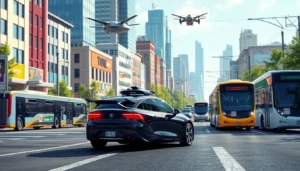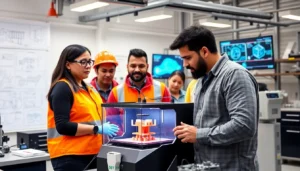Table of Contents
ToggleIn a world where disasters can strike faster than a cat video goes viral, emerging technologies are stepping up to the plate. Artificial Intelligence is no longer just a sci-fi dream; it’s transforming disaster risk reduction (DRR) into a high-tech playground. Imagine AI predicting floods while you’re still figuring out what to binge-watch next—now that’s a game changer!
Overview of Emerging Technologies
Emerging technologies significantly reshape the landscape of disaster risk reduction. Artificial Intelligence plays a pivotal role, enabling enhanced prediction and response capabilities.
Key Technologies in AI
Machine learning, deep learning, and natural language processing drive advancements in AI. Machine learning helps systems learn from data patterns, while deep learning enhances understanding through neural networks. Natural language processing enables machines to interpret and generate human language, improving communication during crises. These technologies empower data analysis, allowing for quicker decision-making in disaster scenarios.
Recent Advancements in AI
Recent advancements in AI demonstrate remarkable potential in disaster management. Predictive analytics now forecasts natural disasters with increased accuracy. Drones equipped with AI algorithms perform real-time assessments of affected areas, providing vital information. Automated systems streamline response efforts by deploying resources efficiently. These innovations contribute to more resilient communities, ultimately reducing risks associated with disasters.
Applications of AI in Disaster Risk Reduction (DRR)
AI significantly enhances disaster risk reduction through innovative applications. Emerging technologies optimize data management, streamline response efforts, and improve community resilience.
Predictive Analytics
Predictive analytics utilizes historical data and machine learning algorithms to forecast potential disasters. These advanced techniques analyze vast datasets to identify patterns and risk factors associated with various hazards. Organizations deploy this technology to predict events like floods or hurricanes, allowing for timely alerts and preventive measures. For instance, effective alerts enable authorities to evacuate at-risk populations swiftly. Furthermore, continuous improvements in AI create more accurate models, enhancing the reliability of predictions in diverse scenarios.
Risk Assessment Tools
Risk assessment tools leverage AI to evaluate vulnerabilities and potential impacts on communities. Through data analysis, these tools identify critical infrastructure and populations most at risk during disasters. Implementing algorithms helps organizations prioritize resources and build strategic response plans. For example, real-time data integration from sensors or satellite imagery allows for dynamic risk assessments. This capability enhances proactive decision-making and facilitates tailored intervention strategies that mitigate damage efficiently. Regular updates of these assessments promote ongoing disaster preparedness and resilience-building initiatives.
Case Studies of AI in DRR
AI technologies are making significant strides in disaster risk reduction. Successful case studies demonstrate the tangible benefits of AI in predicting and managing disasters.
Successful Implementations
In various regions, AI has proven effective in disaster prediction. For example, a machine learning model used in the Philippines predicted typhoon impacts, allowing for enhanced evacuations. Additionally, AI-driven drones conducted real-time assessments after earthquakes, aiding in damage evaluation and resource allocation. In India, predictive analytics facilitated early warning systems for floods, improving community preparedness. These implementations highlighted the importance of combining AI with local knowledge for more accurate risk assessments.
Lessons Learned
Data accuracy emerged as a critical factor in AI applications. Successful case studies emphasized the need for high-quality datasets to enable AI systems to operate efficiently. Collaborating with local authorities enhanced AI models, ensuring they addressed specific community needs. Continuous training of AI models using updated data helped maintain their relevance and effectiveness. Moreover, integrating AI into existing disaster management frameworks proved essential for seamless operations and increased trust among stakeholders.
Challenges and Limitations
Emerging technologies, like AI, face various challenges in disaster risk reduction (DRR). Both ethical concerns and technological barriers significantly impact their effectiveness in this field.
Ethical Concerns
Ethical dilemmas arise when integrating AI into DRR strategies. Privacy issues become prevalent, particularly regarding the collection and use of personal data for predictive analytics. Individuals may express concerns about surveillance and data misuse, which can erode public trust. Moreover, bias in AI algorithms poses a tangible risk, potentially leading to misinformed decisions that disproportionately affect vulnerable populations. Transparency in AI processes is crucial to fostering trust, yet it often lacks in practice. Addressing these ethical concerns must become a priority to ensure fair and effective implementation of AI in disaster scenarios.
Technological Barriers
Technological limitations challenge the deployment of AI in DRR. High-quality data requirements often hinder effective AI operations. Inadequate datasets can lead to ineffective model predictions, which compromise overall response efforts. Infrastructure deficits also pose significant barriers; areas with limited internet access struggle to utilize AI tools that rely on real-time data. Furthermore, the complexity of integrating AI into existing disaster management frameworks complicates collaboration among agencies. Organizations must also contend with a lack of technical expertise, which limits their ability to implement and maintain AI systems. Prioritizing investments in technology and training can enhance AI applications in DRR.
Future Directions
Emerging technologies, particularly AI, shape the future of disaster risk reduction (DRR). These innovations present exciting prospects for further advancements.
Trends to Watch
AI technologies continue to evolve rapidly. Increased adoption of machine learning algorithms enhances predictive analytics capabilities. Real-time data integration from multiple sources aids in developing more dynamic risk assessments. Furthermore, collaborations between governments and tech companies foster innovation in DRR solutions. Community involvement in these technologies promotes trust and efficacy in response strategies.
Opportunities for Innovation
Innovative applications of AI offer new pathways for effective disaster management. Investment in AI-driven resource allocation systems streamlines response efforts during emergencies. Enhanced risk assessment tools utilizing big data analytics provide more accurate evaluations of vulnerable communities. Developing AI technologies that prioritize ethical considerations, such as privacy and bias mitigation, cultivates a more responsible approach to DRR. Focused training and capacity-building for local authorities ensure that communities can leverage these innovations effectively.
Emerging technologies like AI are set to redefine disaster risk reduction. Their ability to enhance prediction and response mechanisms is crucial for building resilient communities. As AI continues to evolve it will empower local authorities and organizations to make informed decisions and improve disaster preparedness.
The integration of AI into existing frameworks offers promising opportunities but also presents challenges that need addressing. Ethical considerations and data quality remain critical for fostering public trust. By prioritizing collaboration and community involvement stakeholders can harness the full potential of AI in DRR.
The future holds exciting possibilities with advancements in machine learning and real-time data utilization. Embracing these innovations will be essential for effective disaster management and reducing risks associated with natural disasters.







